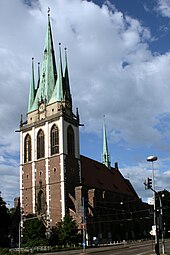St. Georg (Ulm)
The church of St. Georg in Ulm was built as a Catholic garrison church in the years 1902 to 1904 south of the "Old Cemetery" on Olgastraße by the architect Max Meckel . Today it is the parish church of the Catholic parish of St. Georg, established in 1920. Ownership of the church passed from the Federal Republic of Germany to the parish in 1962.
architecture
When building the church, Meckel resorted to late Gothic forms and combined them with contemporary and his own ideas. As one of the few neo-Gothic church buildings that have remained almost unchanged today , it was therefore entered as a cultural monument of particular importance in the Baden-Württemberg monument book. The renovations in 1977/1983 and 1993/1995 were limited to refreshment, repairs and restorations.
construction
The building is designed as a three-aisled basilica , with the central nave being unusually wide, while the side aisles are very narrow. As a main construction material were hand-molded bricks related to white grouting, the roof with Church beaver , the spiers covered with copper are. The roof and tower helmets rest on iron substructures and have a height of 38 (roof) and 86 (tower) meters respectively. The full width of the tower is in front of the central nave.
Interior
The interior of the church is painted. The high altar is designed like a late Gothic winged altar , the figures are based on Gothic models. For the figures of the side altars, the Maria of the Bordesholmer Altar in the Schleswig Cathedral and St. Georg from the main altar of the church of the same name in Nördlingen were models.
The program of images on the ceiling in the central nave is reminiscent of its original function as a garrison church. Two stylized oak trees, "symbol of German loyalty", in whose foliage the coats of arms of the federal states (from 1871) of the German Empire line up, run through the top of the vault .
inauguration
Report in the Ulmer Bilder-Chronik about the consecration of the church:
"1904, November 8th. Inauguration of the new Catholic garrison church. All the bells ring the night before. A wind choir introduces the festival morning with a chant from the church tower. At 8 o'clock the holy consecration by the bishop and clergy begins. The king is welcomed at the main portal by the bishop and building director Meckel. 10:30 am the king and his entourage entered the church, followed by the ministers present, the commanding general, the generals, delegations of the troops and the invited guests. The bishop gives the ceremonial address, after which the appointment of the new garrison pastor takes place. Pontifical Mass and Te Deum end the celebration, which is followed by a tour of the church. "
Walcker organ
The organ was built in 1904 by Eberhard Friedrich Walcker (Ludwigsburg). In 1964 the instrument was restructured by the organ building company Reiser (Biberach). In 2004, the Swiss organ builder Kuhn (Männedorf) restored the instrument and returned it to its original condition from 1904.
The organ has 45 registers and two transmissions . The pipework is largely original. The game actions are mechanical- pneumatic , the stop actions pneumatic. The wind chests are designed as cone chests.
|
|
|
|
|||||||||||||||||||||||||||||||||||||||||||||||||||||||||||||||||||||||||||||||||||||||||||||||||||||||||||||||||||||||||||||||||||||||||||||||||||||||||||||||||||||
- Coupling : II / I, III / I, III / II, I / P, II / P, III / P.
- Playing aids : 5 × 500-fold setting system , tutti , crescendo roller , calcant .
See also
Individual evidence
- ↑ Höhn, Volume 6, Issue No. 62, February 1932, p. 321
- ↑ More information on the history, restoration and disposition of the Walcker organ
literature
- Karl Höhn (Hrsg.): Ulmer Bilder-Chronik. Illustrated monthly about Ulm's past and present. 3rd volume. Containing the time from 1891 to 1914 as well as the years 1931 and 1932 . Höhn, Ulm 1933 (Reprint: Höhn, Ulm 1978, ISBN 3-924392-04-8 )
- Catholic parish St. Georg (Ed.): St. Georg Ulm. 100 years of living history of a church. Süddeutsche Verlags-Gesellschaft, Ulm 2004, ISBN 3-88294-345-9
- Catholic parish of St. Georg (Ed.): St. Georg in Ulm . (= Swabian art monuments; 33). 3rd revised edition. Anton H. Konrad Verlag, Weißenhorn 2016, ISBN 978-3-87437-571-9
Web links
- Website of the Catholic parish of St. Georg in Ulm
- Pictures of the church on www.foto-galerien.de
- Panoramic view of the interior at www.frag-den-spatz.de: (a) and (b)
- Walcker organ of the Georgskirche on www.ulmer-orgeln.de
Coordinates: 48 ° 24 '10.2 " N , 9 ° 59' 50.1" E


